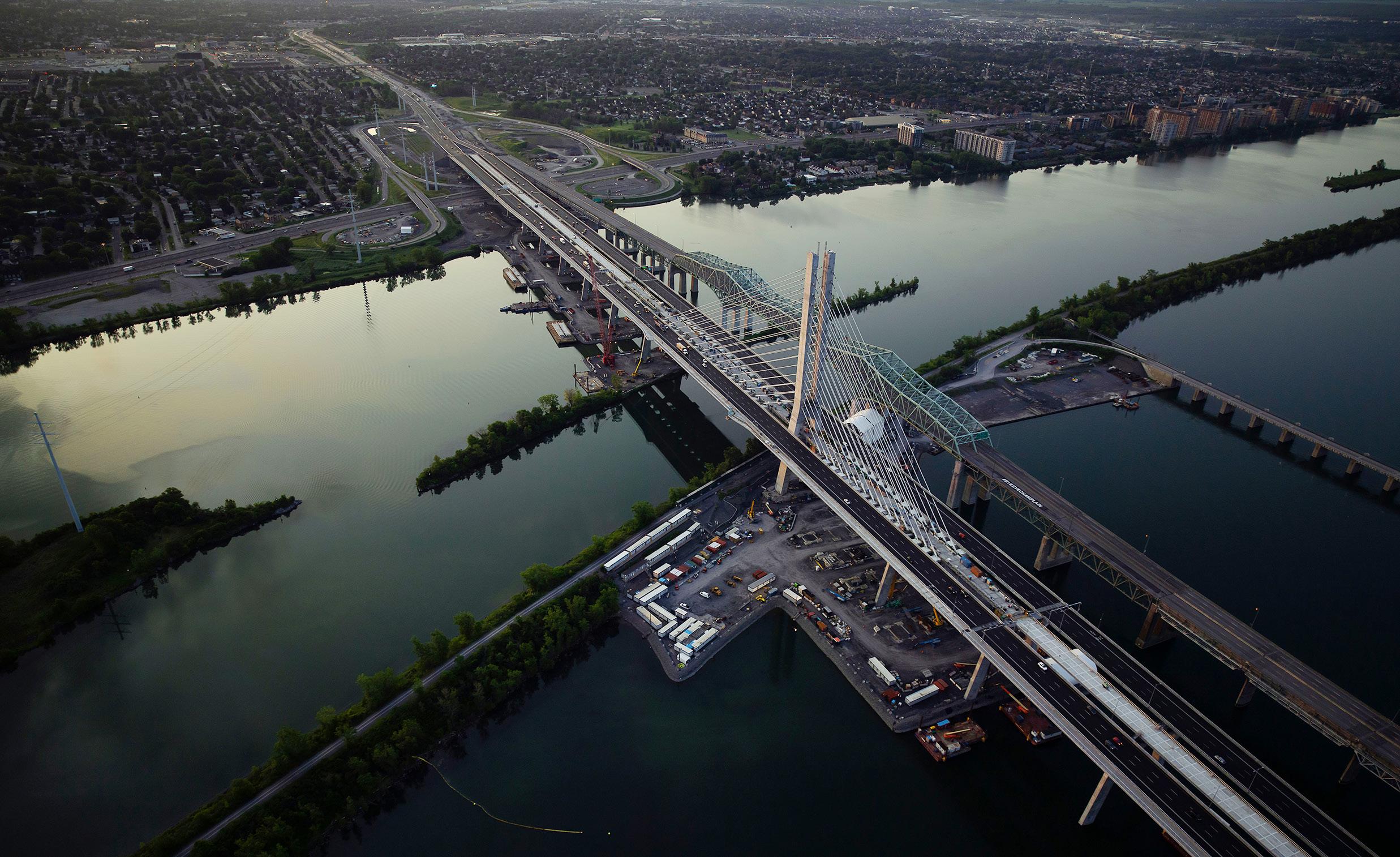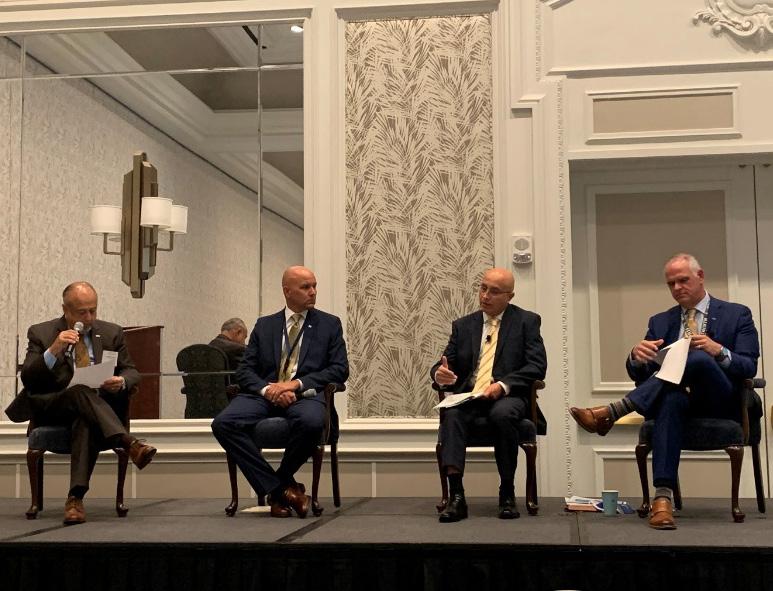
7 minute read
CURRENT EVENTS
Samuel De Champlain Bridge in Montréal, Québec, Canada. (Image credit: ©Thomas Heinser)
Three of TYLI’s Landmark Bridges Presented at 2021 International Bridge Conference®
Three of TYLI’s major Bridge sector projects were in the spotlight at the virtual 2021 The International Bridge Conference® (IBC) this past June. Presented by the Engineers’ Society of Western Pennsylvania, the IBC annually attracts over 1,000 bridge owners and engineers, senior policymakers, government officials, bridge designers, construction executives, and suppliers from throughout the United States and abroad.
Rendering of the I-395 segmental bridges and new signature bridge in Miami, Florida.

Marwan Nader, Ph.D., P.E., TYLI Senior Vice President and Technical Director of the firm’s Bridge sector, presented a paper on the Samuel De Champlain Bridge in Montréal, Québec, Canada, entitled “Public-Private Partnership (P3) Procurement Method and Design-Build Delivery for the Samuel De Champlain Bridge” (IBC 21-45). Marwan’s coauthors on the paper included Guy Mailhot, Eng. M.Eng., FSCE, FEIC, Infrastructure Canada, and Jeff Rogerson, Flat Iron. Opened to traffic on July 1, 2019, the Samuel De Champlain Bridge represents one of the largest infrastructure projects in North America. TYLI, in a Joint Venture with International Bridge Technologies and SNC-Lavalin, served as the Managing Partner and Lead Designer for the 3.4-kilometer-long signature bridge. William Detwiler, P.E., TYLI Principal Project Manager, presented on the “Alternative Technical Concept (ATC) and Aesthetic Project Technical Enhancement (APTE) of the I-395/SR 836/I95 Project in Florida” (IBC 21-46). The I-395/SR 836/I-95 Project is a partnership between the Florida Department of Transportation (FDOT) and the Miami-Dade Expressway Authority (MDX). The centerpiece of the mega project is the signature bridge in front of Miami’s Adrienne Arsht Center for the Performing Arts. After developing several bridge concepts, TYLI managed the design review and is providing technical oversight and postdesign construction services for both FDOT and MDX. Noel Shamble, TYLI Lead Bridge Designer and Visualization Group Director, presented “All Eyes on the Icon: Navigating the Type Selection Process of the I Street Lift Bridge” in Sacramento, California (IBC 21-72). As the winner of a bridge design competition, TYLI was selected as Lead Architect for the I Street Bridge Replacement Project. The chosen design, called the Spring, consists of an 860-foot-long, 100-foot-wide bridge with a unique 300-foot-long basket-handle network tied-arch lifting span. The signature bridge will improve mobility for vehicles, bicyclists, and pedestrians while stimulating the local economy. >>>

TYLI Moderates First-ever Aviation Presentation for ACEC-FL’s Annual Conference
TYLI’s Max Fajardo moderated the first-ever aviation committee presentation at ACECFL’s Annual Conference. TYLI’s Max Fajardo ended his first year as Founding Chairman of the Aviation Committee of the American Council of Engineering Companies of Florida (ACECFL) by moderating the firstever presentation by the Aviation Committee on an industry topic during ACECFL’s Annual Conference.
ACEC-FL has traditionally had a strong presence in surface transportation, with its Transportation Committee acting as the liaison between the engineering consultant community and the Florida Department of Transportation.
In the Summer of 2020, then-ACEC-FL President Shahin Hekmat, P.E. - a friend and classmate of James Kanter, P.E., TYLI’s Fort Lauderdale’s Unit Manager - asked James if he would like to serve on an Aviation Committee being organized for 2020-2021. ACEC-FL’s goal was to expand its reach into Florida’s consulting engineering community by attracting aviation professionals and supporting them as a liaison with airport administrators throughout Florida. James immediately nominated Max as the Founding Committee Chair.
TYLI’s influence in the aviation industry in Florida is significant, and now it had two members on the inaugural Aviation Committee. Max was the clear choice for Founding Chair. Not only did he have a leadership position at TYLI, but Max was also a former Deputy Aviation Director for Capital Improvement Program (CIP)/Operations at Miami International Airport, one of Florida’s busiest airports. Max’s unique understanding of aviation from both the owner and consultant perspectives proved to be critical to establishing the Committee’s mission and agenda. For ACEC-FL’s 2021 Annual Conference, he envisioned a moderated session with guests from each of the three international airports in South Florida: Palm Beach International Airport (PBI), Fort Lauderdale-Hollywood International Airport (FLL), and Miami International Airport (MIA).
On August 5, 2021, Max’s vision became a reality. His panel discussion on “Pandemic Challenges and Recovery of Florida Airport Programs” (ACEC-FL Track) included Ralph Cutié, interim Director and CEO of the Miami-Dade Aviation Department (MIA); Carlos Hernandez, P.E., Construction Management Supervisor for Broward County Aviation Department (FLL); and Gary Sypek, Deputy Director Airports Development at Palm Beach County’s Department of Airports (PBI).
As the moderator, Max led a discussion of thoughtprovoking, open-ended questions about the impact of the pandemic on aviation, challenges faced, and recovery plans with the panelists - who each represented a core area of the aviation industry: planning, airport administration, and construction. >>>

The ACEC-FL aviation committee presentation included (left to right) Max Fajardo, Gary Sypek (PBI), Carlos Hernandez (FLL), and Ralph Cutie (MIA).

(Rikki Chan/Unsplash.com)
Curb Management: A practical start to implementing smart mobility in your community
Written By: Brandon Orr, MCIP, RPP, Mobility Planning Lead at TMIG, a T.Y. Lin International Company, for Ontario Traffic Council A cold November evening in 2013 was when I took my first rideshare, I found myself participating in a paradigm shift as app-based mobility solutions brought the luxuries of ondemand transportation to the average person at affordable prices. What was interesting was not the act of ridesharing (we had taxis for quite a while), but rather the underlying business model and technology that allowed it to exist, and what it represented for the future of mobility and the street curb.
Historically, municipalities had taxi pricing schedules for specific periods that required a license (often referred to as medallions) to limit the supply of taxis, but app-based ridesharing offered a solution that applied the concept of supply & demand in real-time without licensing restrictions. An oversupply of drivers would result in fees going down to attract more riders, while an undersupply would result in higher fees to attract more drivers. Smartphones and 4G telecommunications networks made this possible by allowing services to be adjusted instantly, as opposed to annually or seasonally. Since their introduction many questioned whether the monetary incentive of app-based rideshares and the lack of regulation was a net benefit with companies facing criticism in relation to further contributing to roadway congestion. A 2021 study from the Massachusetts Institute of Technology (MIT) conducted a historical review of travel data across the U.S. and concluded that ridesharing had generally increased road congestion in urban areas with minimal impacts on personal car ownership¹. This is a story that continues to play out in various forms as new private mobility options emerge including e-scooters that currently face criticism for their contribution to urban cluttering and environmental impacts. A study published by North Caroline State University in 2019 estimated that the carbon footprint of e-scooters is ~202g of CO² per Km per passenger over their entire life cycle, which is equivalent to a conventional car and 3.5 times more than an electric one2. The City of Toronto recently opted out of Ontario’s e-scooter pilot in May 2021 stating concerns related to safety, accessibility, enforcement, and liability, which is consistent with several other major North American cities³. The global on-demand mobility market was estimated to be valued at over $99B USD in 2019 and is expected to reach over $238B by 2026 growing at a rate of 15.4% per annum4 . Most rideshare companies are now referred to as Transport Network Companies (TNCs) to emphasize the spectrum of mobility services they offer between ridesharing, bikeshares, e-scooters, and deliveries. Their influence and contributions to mobility are increasing and are projected to continue to be commonplace in our lives as autonomous vehicles (AVs) and vertical take-off and landing (VTOL) vehicles emerge over the next decade and beyond. These realities emphasize the dichotomy between for-profit mobility and public infrastructure and the need for municipalities to be proactive in addressing emerging mobility rather than reactively addressing it. In Ontario there is an estimated $34.7B infrastructure deficit attributed to roads and structures meaning we are falling short on maintaining our existing mobility network5. Regional traffic models, master plans, and land use plans are developed every few years to address a mobility sector that is changing by the day. If our recent experiences have shown us anything, it’s that tomorrow’s mobility technology won’t ask for permission, it will arrive on our street curbs first and beg for forgiveness afterwards. Investing in curbside management presents a practical starting point for your community to manage existing and future needs, mitigate maintenance costs, and create new placemaking opportunities by focusing on getting more out of what you already have rather than building new and costly infrastructure.>>>
________________________ 1 (Diao, Kong, & Zhao, 2021) 2 (Holingsworth, Copeland, & Johnson, 2019) 3 (City of Toronto, 2021) 4 (Globe Newswire, 2020) 5 (Gismondi, 2021).


